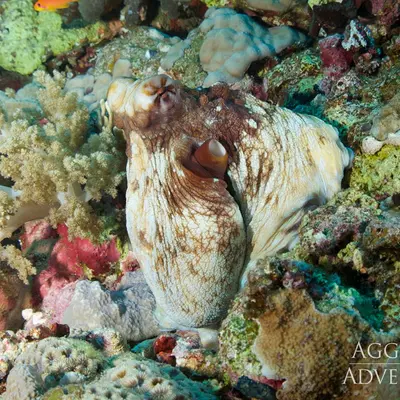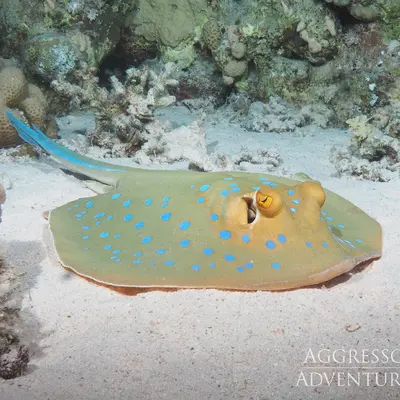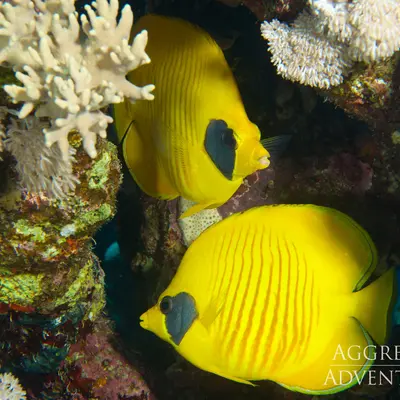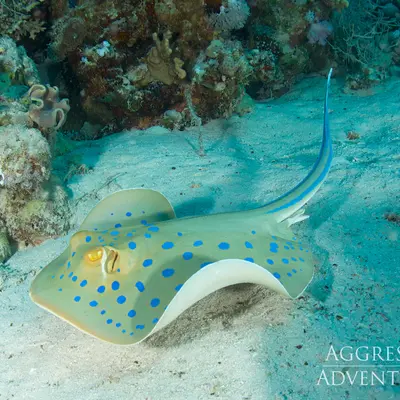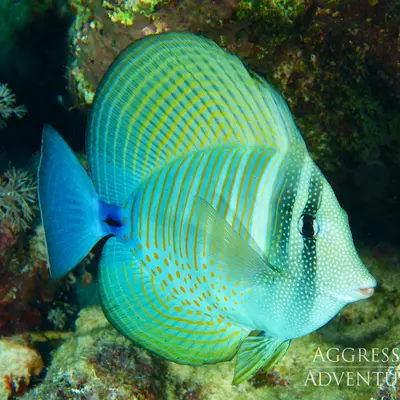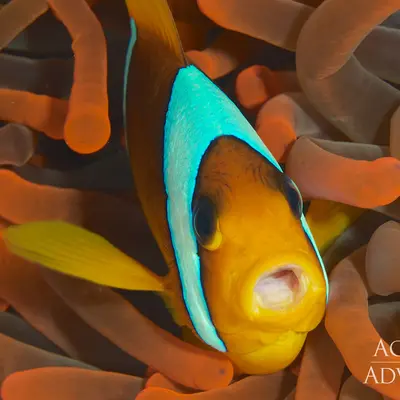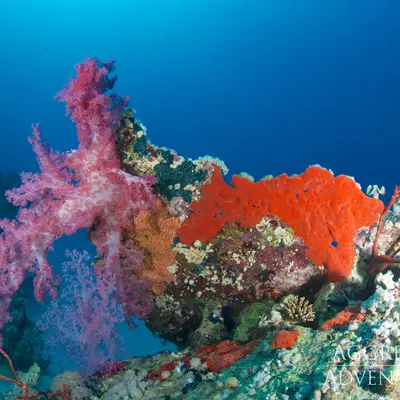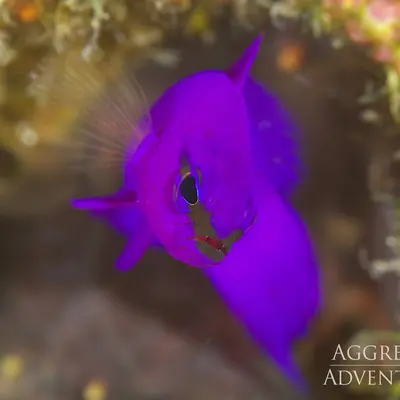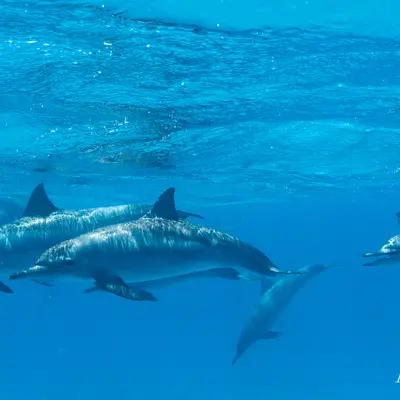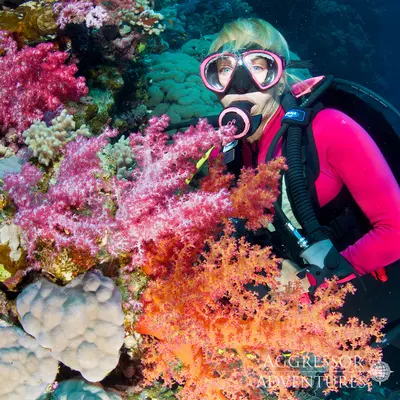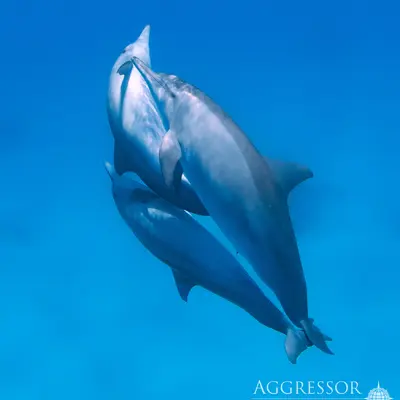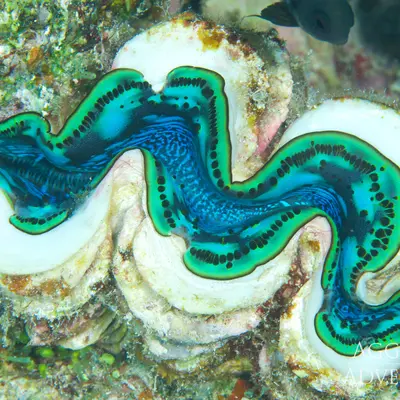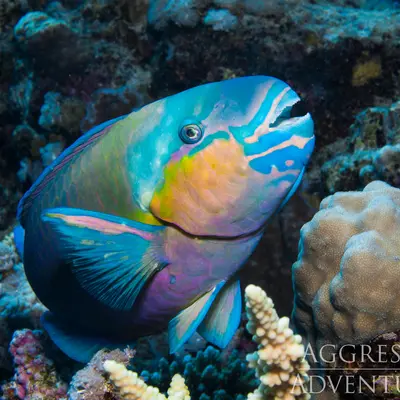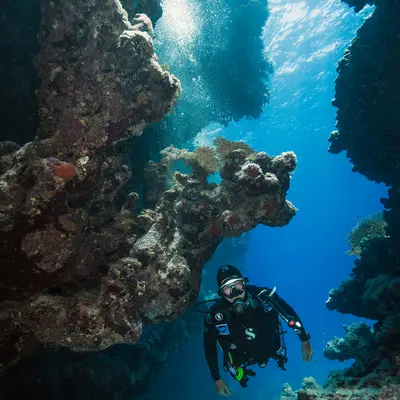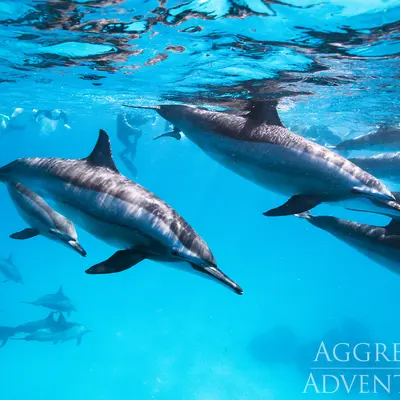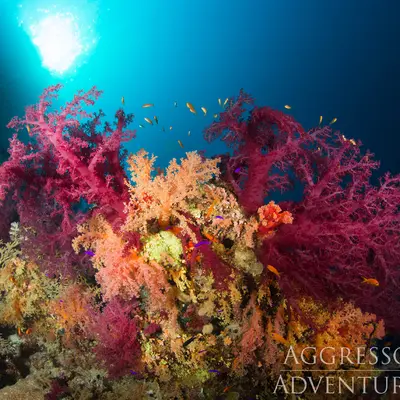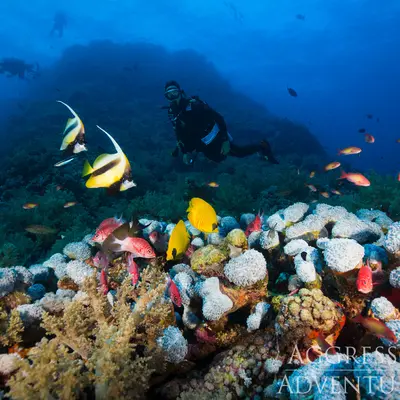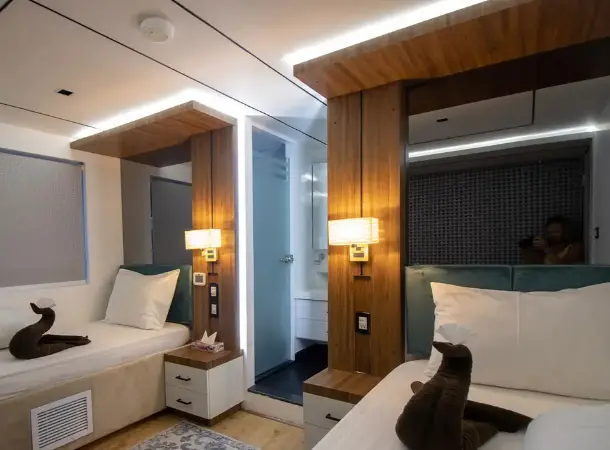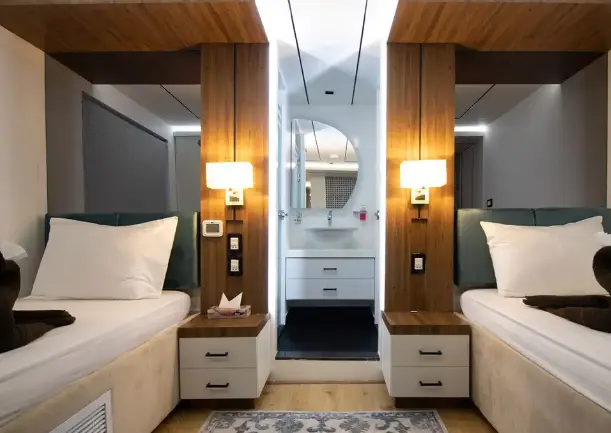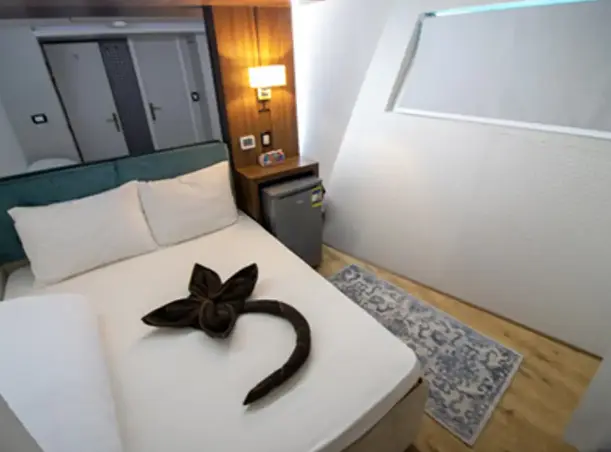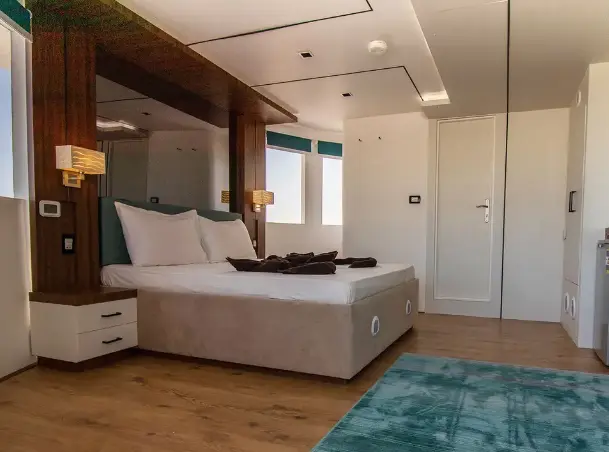The ship sails to numerous popular diving areas in the southern Red Sea - including Daedalus, Brothers, Elphinstone, Sha'ab Maksour and St. John's. The top spots in the region are visited all year round with a wide range of varied tours.
The Red Sea Aggressor IV has two dive tenders to take guests safely to and from the dive sites, as well as modern air compressors that also allow the use of Nitrox.
This website uses Google Maps to embed map material. Please note that your personal data may be collected in the process. To view the Google Maps map, please agree that it is loaded from the Google server.
The Red Sea Aggressor IV is a 43.5 metre long safari ship for divers, which starts its tours from Port Ghalib in the Egyptian part of the Red Sea. There is space for up to 26 guests on board, who are accommodated in 13 comfortably furnished cabins. Three of these cabins are so-called master cabins with queen-size beds, while nine deluxe cabins are each equipped with two single beds. Each cabin has individually adjustable air conditioning, a private bathroom with shower and a hairdryer. Entertainment is provided by a 32-inch TV in each room, on which around 400 films, series and documentaries are available.
The spacious sun deck with shaded area invites you to relax. If you like, you can relax in the whirlpool or chat with other travellers in the lounge or at the bar. Regular film evenings, games and fish identification presentations are held there.

Example Tour St. Jones/Daedalus
Start Saturday 2:00 p.m.
DAEDALUS:
This large reef, also known as Abu El Kizan, is located 80 kilometres off the coast of Marsa Alam. A lighthouse, built by the British in 1861, stands on the small artificial island in the centre of the reef. Today it is occupied by the Egyptian military. The currents here tend to be much more predictable and divers have an excellent opportunity to see large pelagic creatures such as hammerheads and thresher sharks, which are often seen in the north. Manta rays are everywhere (from March to October), and grey reef sharks and whitetip reef sharks patrol the reef walls. Whale sharks occasionally pass by during the summer months. Broccoli corals in various candy colours grow out of the reef on all sides. There are pristine hard coral formations, especially in the north and east, while shoals of glass sweepers live in the overhangs. The southern plateau is covered with yellow Litophyton arboretum and vibrant Xenia. The west has two spectacular sights. "Anemone City" is a section of reef wall covered with magnificent anemone. Further down to the south-west is another section of the wall covered with elephant ear coral. Topographically, the extreme north of the reef is concave. Many different fish such as wrasse, parrotfish, rabbitfish and unicornfish congregate on top of the reef in the clear, shallow water.
ELPHINSTONE:
Elphinstone is a very famous cigar-shaped reef located 6 kilometres from Marsa Alam. There is a long plateau to the north and south of Elphinstone, while the rest of the reef is a steep, colourful wall rich in hard and soft corals. Currents are variable and can be strong or non-existent. Shark sightings are not guaranteed, but the Longimanus cruises in shallow water in season, and from time to time divers encounter hammerhead sharks, grey reef sharks, silky sharks and manta rays. Barracudas hang out in the blue, and cornetfish use divers as cover while they hunt the anthias.
MARSA SHOANA:
Marsa Shoana is a fantastic local dive site in Marsa Alam and usually the first port of call on our itineraries. A white sandy bottom meets a gently sloping reef with small, medium and large coral heads. Divers will encounter many different ecosystems here, which in turn promise a wide variety of large and small marine life. Green turtles, various rays and even dolphins and dugongs surprise those who enjoy the underwater world.
SHA'AB MAKSOUR (Sataya):
Sha'ab Maksour is a large reef with a wide plateau to the north and south and a wall on both sides. There is plenty to see here, including schools of snappers, dogtooth tuna, hawksbill turtles and some of the healthiest stony corals your eyes have ever seen! These corals cover this reef with mounds of porite, dome and pinnacle corals nestled in the shallower parts, as well as pristine table corals sticking out vertically. Some exciting macro life, including the Nembrotha megalocera, has also been spotted here.
SHA'AB CLAUDE:
Sha'ab Claude is a spectacular dive site with its swim-throughs, short tunnels and cavernous chambers. With a depth of less than 15 metres (49 feet), this may not be a deep dive site, but its beauty will amaze you. Light scatters across the rubble floor from cracks in the reef above. Cave sweepers hide in the darkness, catching the light from divers' torches.
MALAHI:
Malahi means "fun" in Arabic and this dive site epitomises that! Large pinnacles are reminiscent of ancient Greek columns, towering over divers and creating corridors lined with hard corals and rocks that meander in one direction or another. Much like underwater corn, these corridors and passages have multiple branches that lead into the heart of the site. Shoals of snappers and goatfish can be found inside, as well as warthogs and nudibranchs.
SATAYA RIFF:
Sha'ab Sataya. Seven imposing stacks of coral called Dha'ab Hassan guard the entrance to the lagoon with depths ranging from 18 metres to 22 metres along the edge, reaching up to 12 metres as you approach Sataya Lagoon. The outer wall of Sataya offers excellent opportunities for drift diving. You will be dropped off by Zodiac and the dive begins at the north-west edge, keeping the reef to the left. Large ledges of soft coral cover the wall and white pinnacles are sometimes spotted half asleep under table coral, slowly moving away as divers approach
ST. JOHN'S CAVES:
The famous St John's Caves are a paradise for photographers and videographers. Sunlight streams through the cracks in the reef of the passages above and falls as dappled sunlight on the rubble and sandy bottom. When visiting the Paradise Reef Elturfa and Elorug Reef dive sites, look out for blue spotted stingrays gliding by and porcupine fish in the shadows. The many corridors are adorned with feathery hydroids that glow red, orange and yellow when they catch the light. George, the friendly Napoleon wrasse, often approaches divers under the boat and checks his reflection in the domes of their cameras. Have fun looking for the juvenile clown coris, bicoloured parrotfish, gold-spotted flatworms and Spanish dancers at night!
Sample routes and maps are for illustrative purposes only. The exact route and locations visited may change depending on local regulations, guest experience, weather and logistics and are at the captain's discretion.
The last dive takes place on the penultimate day of the trip. Divers are advised to wait 24 hours after the last dive before flying.
Short breakfast and check-out at 8:00 am on the last day.
Sample itineraries and maps are for illustrative purposes only. The exact route and sites visited may change depending on local regulations, guest experience, weather and logistics and are at the captain's discretion.
Deluxe cabin twin lower deck
- 2 single beds
- Adjustable air conditioning
- En-suite bathroom
- max. 2 guests
Deluxe double cabin main deck with panoramic window
- 1 double bed
- adjustable air conditioning
- En-suite bathroom
- max. 2 guests
Master cabin upper deck with panoramic window
- 1 double bed
- adjustable air conditioning
- En-suite bathroom
- max. 2 guests
Includes VAT, alcoholic drinks, soft drinks, tea & coffee, drinking water, wine with dinner, snacks, full board (all meals), dive packages, towels for use on deck, cabin towels, complimentary toiletries.
Required extras: harbour fees (50 USD per trip), national park fees (100 USD), visa and fees (25 USD).
Optional extras: travel insurance, diving insurance, tips, rental equipment, nitrox, nitrox course, diving courses, additional dives, snorkelling set.
Prices for rental equipment
Rental equipment is available on this ship. Please indicate on the booking form what you need. Details below of what is included and the additional prices.
- 15 litre bottles: 75-120 USD
- Regulators: 60-90 USD per trip
- BCD: 60-90 USD per trip
- Fins: 50-75 USD per trip
- Mask: 50-75 USD per trip
- Nitrox bottle: 100-150 USD per trip
- Snorkelling set: 50-75 USD per trip
- Torch: 8 USD per day
- Dive computer: 60-90 USD per trip
- U/W camera rental: 100 USD
- Full equipment (with: regulator, BCD, fins, mask, torch, dive computer): 175-260 USD per trip
- Wetsuit: 50-70 USD per trip
- The air temperatures are based on average values for Hurghada and the surrounding area.
- Water temperatures vary throughout the year between around 22 °C in winter and 28 °C in summer.
- Rainfall in this region is minimal, with an average of less than 1 mm per month.
Egypt is located in north-east Africa and connects Africa with Asia via the Sinai Peninsula. The Red Sea stretches along the east coast of Egypt and is an important maritime region with rich marine life, clear waters and unique coral reefs.
Population & Religion
Egypt has over 100 million inhabitants, the vast majority of whom are Muslim (mostly Sunni). There are also small Christian minorities, mainly Copts. Religion plays a central role in social life.
Economic factors & tourism
Tourism is a mainstay of the Egyptian economy. In addition to cultural highlights such as the pyramids and temples, diving tourism on the Red Sea is an important economic factor, especially in regions such as Hurghada, Marsa Alam, Sharm El-Sheikh and Dahab. Diving and beach tourism creates numerous jobs in the hotel industry, catering, travel agencies and as diving guides.
Importance of diving in the Red Sea
The Red Sea is considered one of the most biodiverse seas in the world. It is known for:
- Coral reefs in excellent condition
- Year-round diving conditions due to warm water temperatures
- Diversity of marine life such as dolphins, sharks, turtles, moray eels and colourful reef fish
- Spectacular wrecks, e.g. the SS Thistlegorm
- Good underwatervisibility of up to 40 metres
These conditions make Egypt one of the world's favourite destinations for beginners and experienced divers alike.
Conclusion
Diving in the Red Sea is of great economic and ecological importance for Egypt. Not only does it contribute to regional development, but it also helps to raise awareness for the protection of marine ecosystems. Combined with cultural treasures, Egypt is a unique destination for recreation, adventure and nature experiences.



